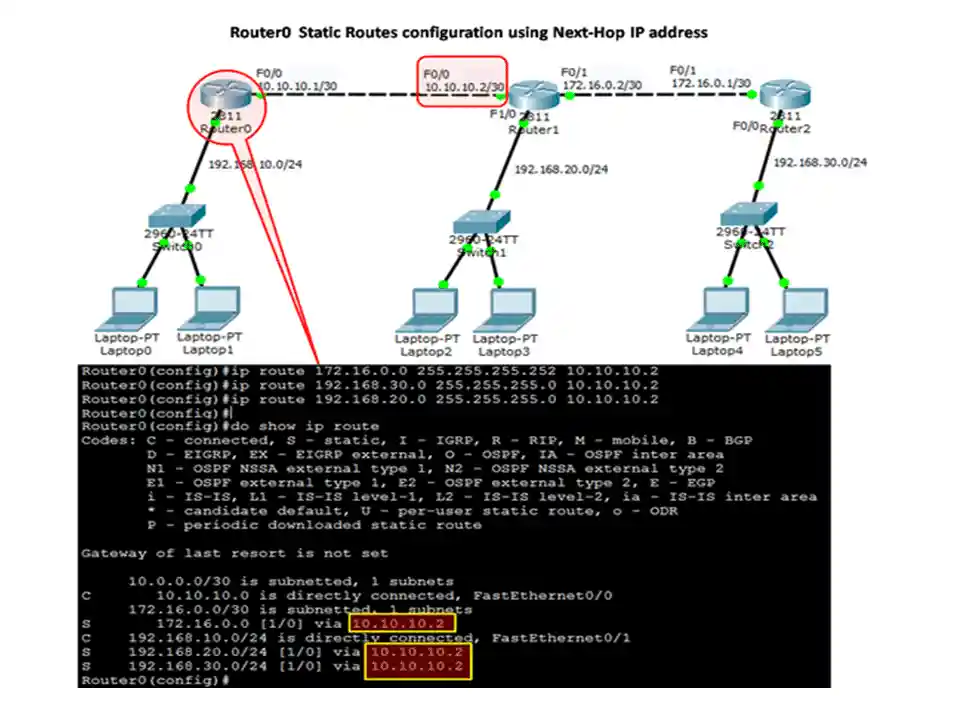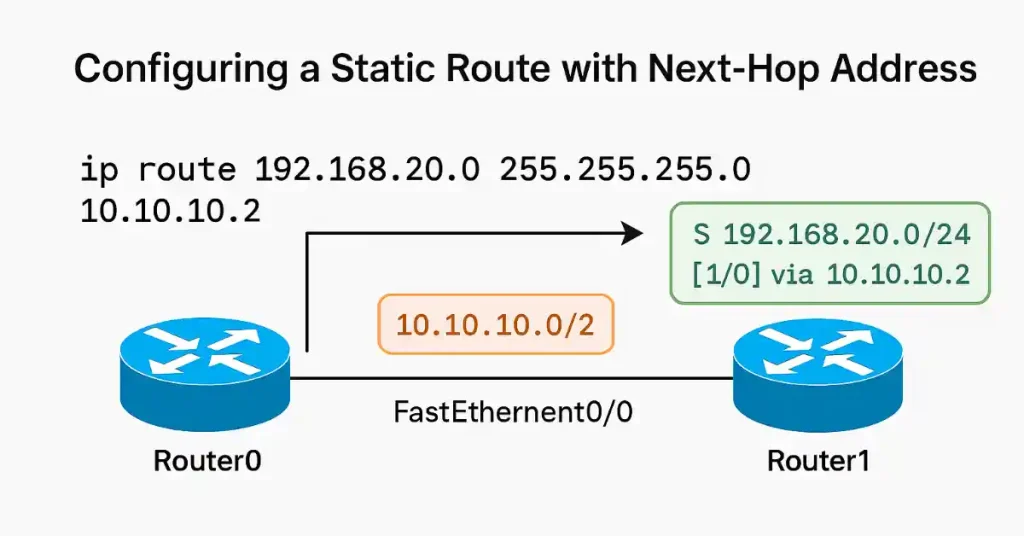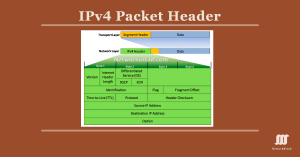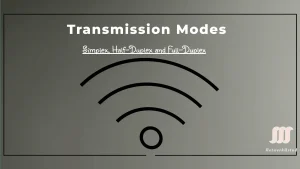Static routing is a fundamental skill for network engineers, essential for directing traffic in small to medium-sized networks or as a backup in dynamic routing environments. For students, understanding how to configure static routes using next-hop addresses is critical for mastering Cisco router configurations. In this lesson, you’ll learn how to configure static routes, understand route resolvability, and explore Cisco Express Forwarding (CEF) to optimize packet forwarding. We’ll break down complex concepts like recursive lookups and provide practical Cisco IOS examples to solidify your understanding. By the end of this article, you will:
- Gain hands-on experience withទ
- Understand the role of next-hop addresses in static routing.
- Learn how routers resolve exit interfaces using recursive lookups.
- Discover how Cisco Express Forwarding (CEF) enhances routing efficiency.
Understanding Route Resolvability and Recursive Lookups
Route resolvability is the process a router uses to determine the exit interface for a packet based on its routing table. When a static route is configured with a next-hop address, the router may need to perform a recursive lookup to find the exit interface, which can impact performance.
How Recursive Lookups Work
Consider a packet destined for the 192.168.20.0/24 network on Router1, with a static route on Router0 pointing to the next-hop address 10.10.10.2:
- Routing Table Lookup: Router0 checks its routing table and finds the static route for 192.168.20.0/24 with next-hop 10.10.10.2.
- Exit Interface Resolution: Since the next-hop is not directly connected, Router0 performs a second lookup to find the exit interface (e.g., FastEthernet0/0) for the 10.10.10.0/24 network.
- Packet Forwarding: The packet is sent out via the resolved interface.
Example Cisco IOS Configuration
Router0(config)# ip route 192.168.20.0 255.255.255.0 10.10.10.2This command configures a static route to 192.168.20.0/24 via the next-hop 10.10.10.2. If 10.10.10.2 is not on a directly connected network, Router0 performs a recursive lookup to find the exit interface.
Why Recursive Lookups Matter
Multiple lookups consume CPU resources, potentially slowing down the router. Cisco Express Forwarding (CEF) eliminates recursive lookups by precomputing routing and adjacency information.
Cisco Express Forwarding (CEF) Mechanism
Cisco Express Forwarding (CEF) is an advanced packet-switching technology used in Cisco routers to optimize performance. Unlike older methods like process switching and fast switching, CEF precomputes routing and adjacency information, eliminating recursive lookups and improving forwarding speed.
CEF Components
- Forwarding Information Base (FIB): A mirror of the routing table optimized for quick lookups, containing destination prefixes, next-hop addresses, and exit interfaces.
- Adjacency Table: Stores Layer 2 information (e.g., MAC addresses) for next-hop devices, enabling direct frame construction without ARP requests.
CEF vs. Other Switching Methods
| Method | Description | Performance |
|---|---|---|
| Process Switching | Each packet triggers a full routing table lookup and ARP query. | Slowest, high CPU usage. |
| Fast Switching | Caches routing decisions after the first packet. | Faster, but still uses ARP. |
| CEF | Precomputes FIB and adjacency tables. | Fastest, minimal CPU load. |
Benefits of CEF
- Speed: Eliminates recursive lookups for faster forwarding.
- Scalability: Handles large routing tables efficiently.
- Stability: Reduces CPU load, improving router performance.
Enabling CEF
CEF is enabled by default on most Cisco routers running IOS 12.0 or later. To verify or enable CEF:
Router(config)# ip cef
Router# show ip cefForwarding Information Base (FIB)
The Forwarding Information Base (FIB) is an optimized version of the routing table. The FIB contains destination information, including next-hop address and other information. The FIB provides a very easy way for routing table lookup and making an easy forwarding decision for the router.
Adjacency Table
The adjacency table contains the information of layer 2 or switching linked to a particular FIB entry, avoiding the need for an ARP request for each table lookup.
The information in both of the above tables works together, so there is no recursive lookup needed for next-hop address lookups. In other words, a static route using a next-hop address requires a single lookup when CEF is working on the router. The following is the video of configuring a static route using the IP address of the next-hop router.
Configure Static Route with Next-Hop Address

Follow these steps to configure static route on a Cisco router using a next-hop address for the topology shown in the above diagram:
Example Scenario – Configure Static Route
- Router0 is connected to Router1 via FastEthernet0/0 (10.10.10.1).
- Destination network: 192.168.20.0/24 (on Router1).
- Next-hop address: 10.10.10.2 (Router1’s interface).
Cisco IOS Commands
Router0> enable
Router0# configure terminal
Router0(config)# ip route 192.168.20.0 255.255.255.0 10.10.10.2
Router0(config)# exit
Router0# show ip routeVerifying the Route
The show ip route command displays the routing table, where you should see
S 192.168.20.0/24 [1/0] via 10.10.10.2This confirms the static route is correctly configured.
Troubleshooting Tips
- No Route: Ensure the next-hop address is reachable (use
ping 10.10.10.2). - Recursive Lookup Failure: Verify the next-hop network is in the routing table.
- CEF Disabled: Enable CEF with
ip ceffor optimal performance
FAQs
What is a next-hop address in static routing?
A next-hop address is the IP address of the router that packets are forwarded to reach a destination network.
Why use a next-hop address instead of an exit interface?
Using a next-hop address allows the router to dynamically resolve the exit interface, making the route more flexible if network changes occur.
What is a recursive lookup?
A recursive lookup occurs when a router must perform multiple routing table lookups to resolve the exit interface for a next-hop address.
How does CEF improve static routing?
CEF precomputes routing and adjacency information, eliminating recursive lookups and improving packet-forwarding speed.
Can I configure a static route without CEF?
Yes, but without CEF, the router may use process switching or fast switching, which are slower and less efficient.
How do I verify a static route on a Cisco router?
Use the show ip route Command to check the routing table and confirm the static route is present.





